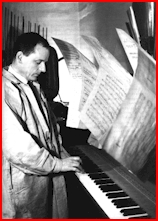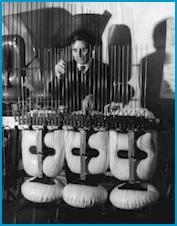|

Francois Baschet
Making the piano wheelbarrow 1964
|
Once the table was
established, the rest was easy. We had already decided that metal had the best resonance.
All we needed to do from there was purchase supplies and assemble the instruments we'd
designed. We'd come up a myriad of possibilities feeling as if we'd stumbled on a miracle.
But before butting the first piece of metal, we took a little time to develop a
philosophy. I got help from an unexpected source when I encountered a charming, young
woman in a train compartment. She was reading a thick volume of Eckermann's conversations
with Goethe. I assured her Goethe was a particular passion of mine and she read me a
passage in which Eckermann asks, "How does one know that something is real,
valid?" Goethe responds, "If it produces something else."
The passage struck me as the definition of our work - to invent forms that are not only
sculptures with a decorative impact, but that produce music, thus letting people express
themselves whether by playing them or by taking advantage of the sculptures' capacity to
be modified for the pure joy of creation. I asked the woman to jot the passage down for
me. She had barely finished when we arrived in Bielefeld. She grabbed her things and
disappeared, making the encounter seem somehow providential and I call this young woman
'the angel of Bielefeld' who left me the message which became the principal of our work.
|
|
Aluminium Piano
Art Deco 1964

|
T h
e L i m i t a t i o n s o f A r t
Once Rembrandt added the last stroke to a painting, the work of art was finished --
unalterable and immobile, a window on a scene from the past. Of course, it has its magic,
its perfection, and the ability to evoke a response from the viewer. That's a lot. But
that's all. Other than changing the frame or adjusting the lighting around it, it can't be
modified. The painting is superb butsterile, like a mule. I'm not the only one who thinks
this way, but it's a thought that can land you incourt. I'll give you an example. We had
gone to New York to give an exhibition at the Museum of Modern Art (MOMA) followed by
another exhibition at the private gallery of Dick Waddell. We had sent the sculptures in
crates. U.S. Customs sent a Mr. Sam Lacher in person. He was the Director of the Art
Section. He asked, "Do your sculptures make music?" Proudly, we answered,
"Not only do they make music, but we're going to give a concert of Bach, Vivaldi,
Bartok ..." "That's too bad," Mr. Lacher interrupted. "Here in the
U.S, art is defined by its uselessness. If your sculptures make music, they're no longer
art, they're instruments and there's a 16% customs charge on their retail value."
Dick Waddell moved heaven and earth to mobilise the art world for us. Alfred Barr,
founding director of MOMA, circulated a petition among the city's gallery directors. John
Canaday, the critic for T h e N e w Y o r k T i m e s who had written a very favourable
review about us, applied media pressure. The "Brancusi scandal" was
resuscitated, because, the first time Brancusi sent his sculptures to New York, customs
declared, "These aren't works of art. They're rocks that don't resemble anything.
There's a charge for that."
The art world mobilised for Brancusi as well. He went to court and won. Thanks to the
Brancusi Amendment, abstract art became duty free. We also went to court ... and won. Dick
Waddell announced the news to us, adding that not only had we changed the United States
law, but there was now a Baschet Amendment on the books. We are very proud of that. Our
"sculptures that make music" might have landed us in court, but they also
prompted us to go further in our artistic research, allowing us to open doors to new means
of artistic expression.
|
 |
A
N e w C o n c e p t i n I n s t r u m e n t s
Classical instruments are as light as possible. They work like a fan, giving off little
gusts of air. The ear hears a sound when these gusts have a frequency greater than 20 per
second (1/20th of a Hertz). It's therefore imperative that the fan be light. Our
instruments are based on another principal. They create vibrations along heavy metal rods.
Additional metal elements placed on the rods produce accessory sound, such as harmonics,
echoes and resonance's. This allows us to "cook" the sound the way one adds fine
herbs to a lamb stew. This specially seasoned sound is amplified by cones much like a
trumpet's bell but enlarged to accommodate the sculpture. The larger surface and it's
elasticity create ample vibrations that play the role of the above-mentioned fan. By
changing the vibrating elements, one obtains an acoustical synthesiser. But the form, the
size, the material from which the cones are made also influence the sound. This allows for
an infinite variety of possibilities. Furthermore, there is enough liberty in choosing the
form of the cones to bring them into the realm of visual aesthetics thus qualifying them
as sculpture.
|
|
Jacques Lasry playing 3 octave
glass rods, amplified by plastic
balloons 1956

Large 3 coned sculpture with metal
rods
|
S c u l p t u r e
In 1966, Ludwig Glaeser, curator at MOMA, invited us to New York to give an exhibition
that lasted four months. Alfred Barr purchased one of our sculptures for the Museum saying
it was the only new thing to arrive from the Old Country since the Second World War. The
sound sculptures' adaptability allows for sculptures of any size from a cathedral's bell
tower to amusical clock. The cone's rounded, folded form led us to perfect a kind of
origami for sheets of metal. We were happy to discover that the technique could be used as
well for the amplifiers, the blades of our musical windmills and the bowls of our sound
fountains. The book, K l a n g O j e k t e, published by Eberwald (Munich) and illustrated
by Alain Villeminot, describes the construction of sound fountains and windmills. The book
is used in German trade schools for job-training courses that teach the students physics,
acoustics, the dynamics of liquids and even the plumbing involved, and helps them develop
their creativity. My brother, Bernard, putting his virtuosity at folding sheets of
stainless steel to use, has come up with another application in another form of sculpture
for our exhibitions. His metal origami doesn't produce any sound. The harmony of its form
is sufficient in itself. Bernard calls these sculptures his "silences." Based on
the acoustical principals Bernard and I have established, I came up with another concept,
having developed and copyrighted do-it-yourself kits for sound sculptures. As described in
the brochure:
"It will allow the enthusiast to make 'non-electronic synthesisers.' By adding or
combining resonators, damping elements and sound radiators, it will be possible not only
to create the sound you want, but also to give to the sound sculpture the shape and degree
of complication you desire." Alas, I am a better artisan than a businessman and have
yet to find a distributor for the kit.
H a n d s O n
From our very first concerts in 1955, we've noticed that our audiences have been as
interested in the sounds and music as in the structure and function of our sculptures. We
began to invite the audience to come up on stage after our concerts for a chance to try
the instruments out. Furthermore, in the exhibition rooms where most museums display
"Do Not Touch" signs everywhere, we post signs that read, "Please
Play." It's one of the reasons are exhibitions have always been successful, and it's
led to interesting reactions. In 1965, we had an exhibition at Stockholm's museum of
modern art, the M o d e r n a M u s e e t. The main room was crowded. Entire families,
form grandparents to children, came. The noise was considerable. Everyone was playing the
different sculptures with the exception of seven or eight large, blond Swedes who stood
watching, mesmerised, in the midst of all the racket. Their immobility seemed so out of
place, I approached them and asked,
"Are you waiting to play
something?"
"No."
"Are you simply listening then?
"No."
"Well, what exactly are you looking at?"
"We've never seen so many happy Swedes in one place unless they were drunk."
During an exhibition at Barcelona's Miro Foundation in 1978, I'd become a good friend of
one of the guards. At the end of the exhibition, he said to me,
"I want to ask you something that you'll probably find silly, but, for the last
month, I've watched hundreds of people enter, looking tired from their daily cares.
Fifteen minutes later they leave laughing and happy. How do you perform this miracle? Are
you an extraterrestrial?"
|
|
Jacques Lasry
Yvonne Lasry
Daniel Ouzounof
|
T h e M u s i c
For all the musical possibilities our sculptures create, musicians are necessary. In 1954,
my brother and I were lucky enough to meet Jacques and Yvonne Lasry. Jacques was a pianist
and composer. Yvonne was an organist. Her solid Alsatian background had also given her a
moral equilibrium like no one else's that provided balance to these otherwise very
different artists. Their task was difficult. It wasn't merely a question of performing.
The Lasrys also had to adapt old techniques and invent new ones to play instruments that
had never existed before.
|











